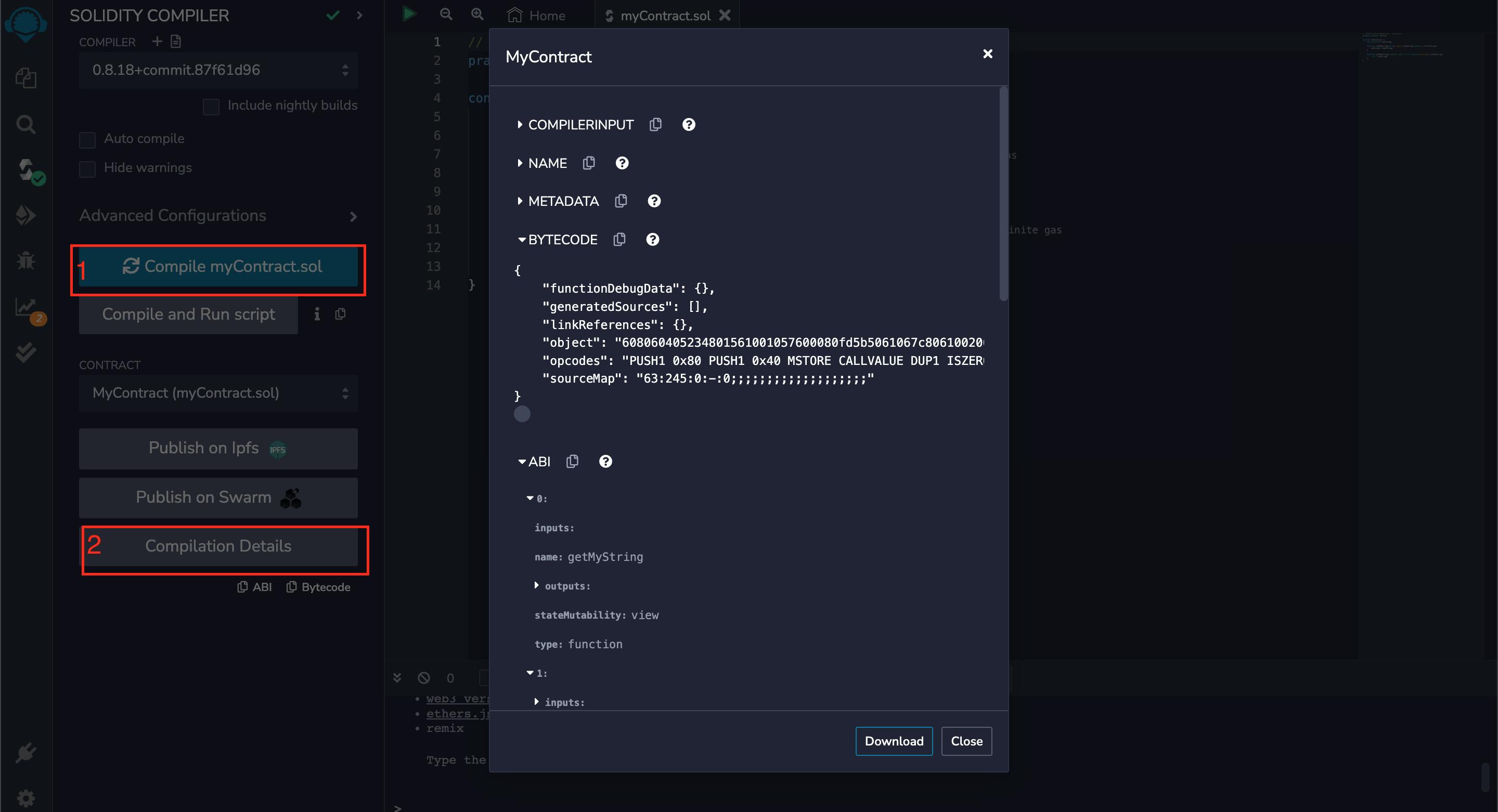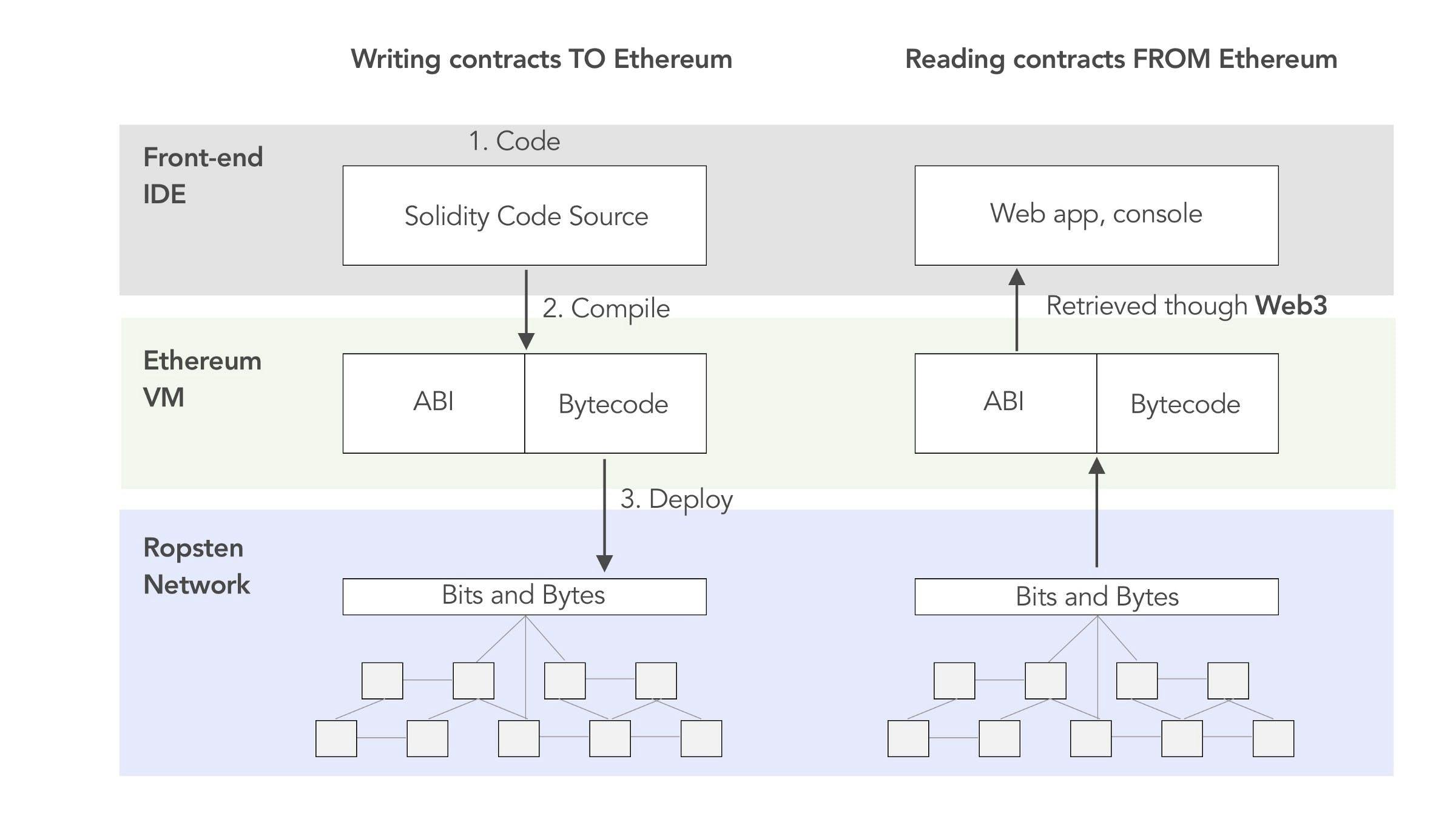Understanding ABI and Bytecode in Ethereum Smart Contract Development: Concepts, Tools, and Best Practices
Blockchain technology has become a popular solution for various industries, from finance to supply chain management, to healthcare. In particular, Ethereum has emerged as a leading platform for developing decentralized applications (dApps) due to its ability to execute smart contracts. Smart contracts are self-executing contracts that are programmed to execute automatically when certain conditions are met.
In this article, we'll provide an introduction to ABI and bytecode in Ethereum smart contract development, covering their concepts, tools, and best practices.
Bytecodes
Bytecode is a low-level representation of computer code that is designed to be executed by a virtual machine. When a program is compiled, it is typically translated into machine code that can be executed directly by the CPU. However, bytecode is different - it is designed to be executed by a virtual machine that emulates the behavior of a CPU.
The advantage of using bytecode is that it is portable - because it is executed by a virtual machine rather than directly by the CPU, it can be run on any platform with a compatible virtual machine. This makes bytecode an ideal choice for programming languages that need to be cross-platform.
What is bytecode in Ethereum?
Bytecode in Ethereum refers to the low-level machine-readable code that is stored on the blockchain and executed by the Ethereum Virtual Machine (EVM). Smart contracts in Ethereum are written in a high-level programming language like Solidity and then compiled into bytecode that can be executed by the EVM.
When a smart contract is deployed on the Ethereum blockchain, its bytecode is stored on the blockchain as a transaction. The EVM executes the bytecode to validate transactions and execute smart contract logic since the bytecode is executed by the EVM. Hence, it is platform-independent, meaning smart contracts can be executed on any Ethereum node regardless of the hardware and software it is running on.
Here's an example of what bytecode looks like for a simple smart contract written in Solidity:
608060405234801561001057600080fd5b506101f4806100206000396000f3fe60806040526004361061003b5760003560e01c806360fe47b1146100405780636d4ce63c1461007f575b600080fd5b34801561004c57600080fd5b506100556100d0565b6040518082815260200191505060405180910390f35b6100706100e5565b005b60006020819052908152604090205460ff1681565b6000805490509056fea165627a7a723058203dcd3f1c7a2f2d9b7ed8d580aaf44c30f03111814a35c3fb3dceee130bdc2f2b0029
The bytecode is a sequence of hexadecimal numbers that represent the actual machine code that is executed by the EVM. The bytecode is generated when the Solidity source code for the contract is compiled.

The above image shows the steps to view your contract details - bytecodes and ABI. You can also copy out the bytecode after compiling.

ABI
ABI stands for Application Binary Interface, and it is a specification that defines how two pieces of software interact with each other. Specifically, an ABI specifies things like how functions are called, how data is passed between the two programs, and how errors are handled. By standardizing these interactions, an ABI makes it possible for software written in different programming languages or on different platforms to work together seamlessly.
One way to think about an ABI is as a contract between two programs. Just like a legal contract specifies the rights and responsibilities of each party, an ABI specifies how two programs will interact with each other. This makes it possible for developers to write software that works with other software, even if they don't have direct access to the source code.
What is ABI in Ethereum?
Smart contract ABI specifies how smart contracts can be called and interacted with by other contracts or external applications. ABI is used to encode and decode messages sent to and from a smart contract, which makes it possible for different contracts and applications to interact with each other seamlessly.
In Ethereum, the Contract ABI is a specialized version of ABI that defines a set of encoding rules that can be used to represent the interface of a smart contract, including its functions, data types, and argument types. The Contract ABI includes the following elements:
Function Selector: The function identifier is a four-byte hash of the function name and parameter types. This identifier is used to uniquely identify the function on the blockchain.
Input Parameters: data types and order of the input parameters for a function. This is an array of objects with the following:
name: the name of the parameter.
type: the type of that parameter.
components: used when the type is a tuple.
Output Parameters: data types and order of the output parameters for a function that is similar to the input parameter.
stateMutability: a string that indicates whether a function modifies the state of the contract, and if so, to what extent. Values are view, pure, view, nonpayable, and payable.
Here's an example of an ABI:
{
"inputs": [
{
"internalType": "uint256",
"name": "x",
"type": "uint256"
}
],
"name": "set",
"outputs": [],
"stateMutability": "nonpayable",
"type": "function"
}
In the above ABI example, the set function takes a single input parameter of type uint256. It does not return any values (outputs is an empty array). The stateMutability field is set to nonpayable, indicating that the function modifies the state of the contract but cannot receive Ether.
Tools
Remix IDE
Remix IDE is a web-based Integrated Development Environment (IDE) that is specifically designed for developing smart contracts on the Ethereum blockchain. It includes a Solidity compiler, an Ethereum Virtual Machine (EVM) for testing and debugging smart contracts, and a built-in editor for writing and deploying smart contracts.
One of the main advantages of Remix IDE is that it includes a Contract ABI generator, which makes it easy to generate and verify ABI code for smart contracts. This feature is particularly useful for developers who are new to smart contract development and may not be familiar with the nuances of ABI code.
Web3.js
Web3.js is a JavaScript library that provides a set of tools for interacting with the Ethereum blockchain. It includes a set of APIs that can be used to interact with smart contracts, including sending transactions, reading contract data, and listening to events.
Web3.js also includes a Contract class that can be used to interact with smart contracts in a more user-friendly way. The Contract class allows developers to create a contract instance by providing the contract address and ABI code, and then call functions on the contract instance using a more familiar JavaScript syntax.
Etherscan
Etherscan is a blockchain explorer that provides a wide range of tools and services for analyzing and tracking transactions on the Ethereum blockchain. One of its main features is the ability to view the bytecode of deployed smart contracts and analyze how they work.
Best practices for using ABI code in Ethereum smart contract development
Generating ABI code with Remix IDE is a straightforward process, but there are some best practices to keep in mind when using ABI code in Ethereum smart contract development:
1. Store your ABI code securely
ABI code contains sensitive information about your smart contract, including its functions and data structures. It's important to store your ABI code securely and only share it with trusted parties. Storing your ABI code on a public repository like GitHub is not recommended.
2. Test your ABI code thoroughly
Before deploying your smart contract, make sure to test your ABI code thoroughly to ensure that it works as expected. You can use Remix IDE to test your ABI code by creating a test script that calls your contract's functions and verifies the results.
3. Use a consistent naming convention for your functions
When defining your smart contract's functions, use a consistent naming convention for your function names and input/output parameters. This will make it easier for other developers to understand your code and use your ABI code in their own projects.
4. Update your ABI
As smart contracts evolve and new functionality is added, the ABI may need to be updated to reflect these changes. It is important to keep track of ABI changes and ensure that external applications and contracts are updated accordingly to avoid compatibility issues.
Summary

Bytecode is the low-level code that is executed by the Ethereum Virtual Machine (EVM) when a smart contract is deployed. The bytecode is used to generate the ABI code for a smart contract. The ABI code provides a higher-level interface that defines how external applications and contracts can interact with the smart contract, while the bytecode represents the actual implementation of the contract that is executed by the EVM.
In addition to remix IDE, Web3.js, and etherscan, there are many other tools and resources available. By familiarizing yourself with these tools and learning how to use them effectively, you can become a more proficient Ethereum smart contract developer and build more secure and efficient contracts.